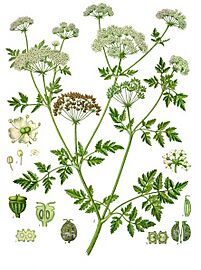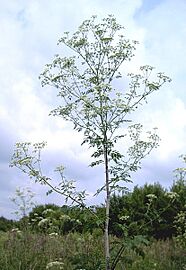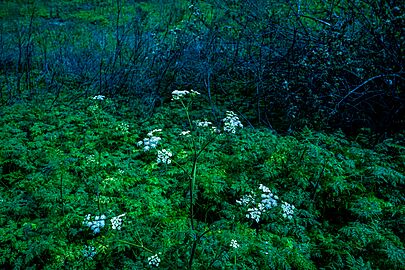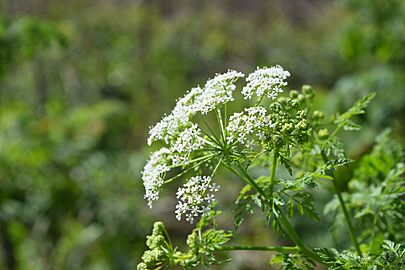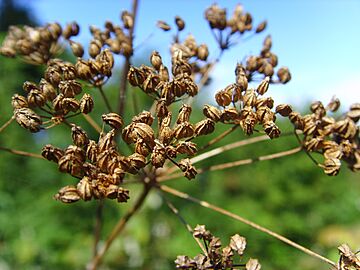Conium maculatum facts for kids
Quick facts for kids Conium maculatum |
|
|---|---|
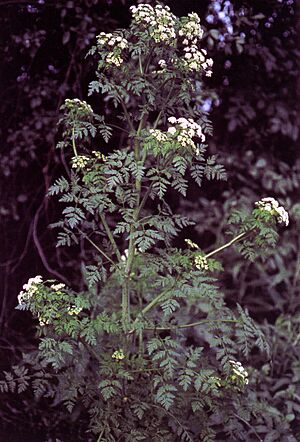 |
|
| Conium maculatum in California | |
| Scientific classification | |
| Genus: |
Conium
|
| Species: |
maculatum
|
Conium maculatum, often called hemlock or poison hemlock, is a very poisonous flowering plant. It belongs to the carrot family, Apiaceae. This plant is originally from Europe and North Africa. It's a herbaceous plant, meaning it doesn't have woody stems like trees. It lives for two years, which is called a biennial lifecycle.
Poison hemlock is very tough and can grow in many different places. It has spread to other parts of the world, like Australia, West Asia, and North and South America. Because it spreads easily, it can become an invasive weed.
Every part of this plant is poisonous, especially its seeds and roots. It's very dangerous if eaten. Hemlock can grow quickly and reach heights of about 8 feet (2.4 meters). It has a long root that goes deep into the ground. The plant has a strong, often unpleasant smell that can travel on the wind. Its hollow stems usually have dark maroon spots. After the plant dies, these stems become dry and brown. Even dead, the hollow stems can stay deadly for up to three years.
Contents
What Does Poison Hemlock Look Like?
Poison hemlock is a flowering plant that usually grows between 5 and 8 feet (1.5 to 2.5 meters) tall. Some can even reach 12 feet (3.6 meters)! All parts of the plant are smooth and hairless.
Hemlock has a green, hollow stem that often has red or purple spots or streaks. Its leaves are large, up to 20 inches (50 cm) long and 16 inches (40 cm) wide. They are finely divided and look lacy, shaped like a triangle. The flowers are small and white. They grow in loose, umbrella-shaped clusters, and each flower has five petals.
As a biennial plant, hemlock first grows leaves close to the ground in its first year. It doesn't produce flowers until its second year. In its second year, it grows tall and produces its white, umbrella-shaped flower clusters.
-
A hemlock plant in Chino, California
How to Tell it Apart from Other Plants
Poison hemlock can look a lot like other harmless plants. For example, it's sometimes confused with the wild carrot plant (Daucus carota), also known as Queen Anne's lace.
Here’s how to tell them apart:
- Wild carrot has a hairy stem and no purple spots. It also grows shorter, usually less than 3 feet (1 meter) tall.
- Poison hemlock has a smooth stem with purple spots. It also grows much taller, usually at least 5 feet (1.5 meters).
Hemlock can also be confused with harmless cow parsley (Anthriscus sylvestris).
It's important not to confuse poison hemlock with the Tsuga tree, which is a type of evergreen tree sometimes called "hemlock" in North America. They are completely different plants. Also, don't confuse it with Cicuta, known as water hemlock, which is another poisonous plant but different from Conium maculatum.
What's in a Name?
The name "Conium" comes from the Greek word koneios. This word means 'spin' or 'whirl', which refers to the dizzying feeling you get if you accidentally eat the plant's poison. The common name "hemlock" most often refers to this specific plant, C. maculatum.
The plant was first officially described by Carl Linnaeus in 1753. He was a famous scientist who named many plants and animals. The word "maculatum" means 'spotted'. This refers to the purple spots often seen on the stems of the plant.
Different Names for Hemlock
In places like Britain and Australia, people usually just call it "hemlock." In America, it's more commonly known as "poison hemlock." Other names include spotted hemlock or poison parsley. Sometimes, in Australia, it's called wild carrot or wild parsnip. In Ireland, it might be called devil's bread.
Where Does Poison Hemlock Grow?
Poison hemlock is originally from Europe and the Mediterranean region.
Today, you can find it in many places around the world. It has spread and now grows in parts of Asia, North America, Australia, and New Zealand. In the British Isles, it grows in many counties, especially in Ulster. In southeast Australia and Tasmania, it's sometimes seen near rivers. Because it's so poisonous, finding it and people coming into contact with it can sometimes be big news in the U.S.
How Does it Fit into Nature?
This plant often grows in wet soil, like near streams, ditches, or other watery areas. You can also find it along roadsides, at the edges of farm fields, and in waste areas. It likes damp soil but can also grow in drier grassy areas and places where the ground has been disturbed.
Poison hemlock grows in the spring. At this time, many other plants haven't fully grown their leaves or flowers yet. All parts of the hemlock plant are poisonous.
Some insect larvae, like those of the silver-ground carpet moths, eat hemlock. The poison hemlock moth (Agonopterix alstroemeriana) especially likes to eat it. This moth has even been used by people to help control the spread of the hemlock plant.
Why is Poison Hemlock Dangerous?
Hemlock contains special poisons called alkaloids, like coniine. These poisons are harmful to all mammals and many other living things that eat the plant. Animals like cattle, pigs, sheep, goats, donkeys, rabbits, and horses have gotten sick from eating it.
For adult humans, eating just a small amount, like six to eight hemlock leaves, can be deadly. This is because the poisons can stop your breathing. The seeds and roots are even more poisonous than the leaves. Farmers must be careful to make sure that hay fed to their animals doesn't have hemlock in it. Hemlock is most poisonous in the spring.
The Poisons in Hemlock
Conium maculatum is known for being extremely poisonous. Its tissues contain several different alkaloids. The main poison is called coniine. These alkaloids are thought to help attract pollinators like butterflies and bees.
Coniine works on the body in a way similar to nicotine. It affects the central nervous system. Because it's so strong, even a small amount can cause breathing problems and lead to death.
The alkaloids in hemlock can also make animals feel cold. They can also make the heart beat faster. Coniine can also harm the kidneys.
What Happens if You Get Poisoned?
Soon after someone eats hemlock, the poisons can cause muscles to stop working. This can lead to the muscles used for breathing becoming paralyzed, which means you can't breathe. This can cause death because the body doesn't get enough oxygen.
If someone is poisoned but doesn't die, they might recover on their own. This happens if they don't eat any more of the plant. If breathing stops, doctors can use a machine to help the person breathe. This can save a life until the poison wears off, which might take 48 to 72 hours. For an adult, eating more than 0.1 gram of coniine (about six to eight fresh leaves, or less of the seeds or root) can be deadly.
The symptoms are similar to those caused by a poison called curare. It starts with muscles becoming paralyzed, moving upwards in the body. This eventually paralyzes the breathing muscles.
Sometimes, animals that have been poisoned by hemlock might go back and eat the plant again. If pregnant animals eat small amounts of hemlock, their babies can be born with problems. These problems include a cleft palate or twisted joints. This damage to the unborn baby is permanent. Even though surgery can sometimes fix twisted joints, most of these malformed animals die. It's hard to know exactly how many animals are affected this way because the poisoning happens much earlier than the birth defects.
There is no specific medicine to stop the effects of hemlock poisoning. So, preventing animals from eating the plant is the best way to avoid these problems. Farmers can use special sprays to kill the plant. They can also let animals like sheep graze, as sheep are less affected by the plant. It's a common myth that hemlock poisons can get into human food through milk or chicken meat. However, scientific studies have shown this is not true.
Hemlock in History
In ancient Greece, hemlock was used to execute prisoners who were sentenced to death. One of the most famous victims of hemlock poisoning was Socrates. He was a very famous philosopher. In 399 BC, Socrates was accused of not respecting the gods and of misleading young men in Athens. He was sentenced to death at his trial. He chose to drink a strong liquid made from hemlock.
See also
- List of poisonous plants


